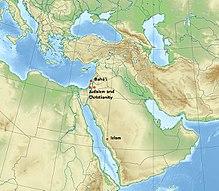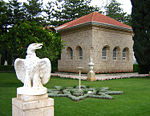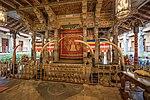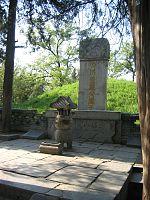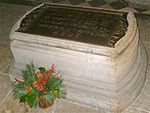This article lists the purported relics of major figures of religious traditions. If there is no burial place or relics, the place of death is mentioned.
Bábism
The Shrine of the Báb, the burial location of the Báb, the founder of Bábism and one of three central figures of the Baháʼí Faith, is located on Mount Carmel, in Haifa, Israel.
Baháʼí Faith
Located in Bahji near Acre, Israel, the Shrine of Bahá'u'lláh is the most holy place for followers of the Baháʼí Faith. This also serves as their Qiblih, or direction of prayer. It contains the remains of Bahá'u'lláh, founder of the Baháʼí Faith and is near the spot where he died in the Mansion of Bahji.
Buddhism
Gautama Buddha's body was cremated in Kushinagar, India and the relics were placed in monuments or stupas, some of which are believed to have survived until the present. Ramabhar Stupa in Kushinagar was built over a portion of the Buddha's ashes on the spot where he was cremated by the ancient Malla people. The Temple of the Tooth or Dalada Maligawa in Sri Lanka is the place where the right tooth relic of Buddha is kept at present.
Christianity
According to early Christian sources the Church of the Holy Sepulchre occupies the location where Jesus is said to have been entombed between his crucifixion and resurrection. It is located in the Christian Quarter of the Old City of Jerusalem.
A second site, known as the Garden Tomb, located just outside Jerusalem's Old City has become a popular Protestant alternative to the Church of the Holy Sepulchre, which is dominated by the Catholic and Orthodox faiths.
Christian Science
Mary Baker Eddy is buried at Mount Auburn Cemetery in Cambridge, Massachusetts in the United States.
Lutheranism
Martin Luther upon his death was buried in All Saints' Church in Wittenburg. This was the formerly Catholic Church to which he nailed his 95 theses. Today it is a Lutheran church.[1]
Latter-day Saints
Joseph Smith is buried at the Smith Family Cemetery in Nauvoo, Illinois in the United States.
Confucianism
The grave of Confucius, founder of Confucianism, is in his hometown of Qufu, Shandong Province, China. The grave of Confucius is located in a large cemetery where more than 100,000 of his descendants are also buried.
Islam
According to early Muslim sources, Muhammad is buried in the Al-Masjid an-Nabawi ("Mosque of the Prophet") in the city of Medina in Saudi Arabia. The tomb of Muhammad lays within the confines of what used to be his house. During his lifetime, it adjoined the mosque, which was expanded during the reign of Caliph al-Walid I to include his tomb.[2] His tomb is located in the southeast corner of the Masjid. A green dome was made over his tomb as well as the tomb of the early Islamic caliphs Abu Bakr and Umar.
Judaism
According to Deuteronomy 34:6, the grave of Moses is on or near Mount Nebo just east of the Jordan river, now in the kingdom of Jordan.
The Cave of the Patriarchs is located in the ancient city of Hebron. Jewish, Christian, and Islamic tradition holds that the compound encloses the burial place of four biblical couples: Adam and Eve; Abraham and Sarah; Isaac and Rebekah; Jacob and Leah. According to Midrashic sources, it also contains the head of Esau, the brother of Jacob.
Scientology
Upon his death, L. Ron Hubbard was cremated and his ashes were scattered in the Pacific Ocean.
Sikhism
Gurdwara Kartarpur (meaning "The Abode of God") was established by Guru Nanak, the founder of Sikhism in 1522. When Guru Nanak died in 1539, Hindus and Muslims disagreed on how to perform his last rites. A samadhi (according to Hindu tradition) lies in the gurdwara and a grave (according to Muslim traditions) lies on the premises as a reminder of this discord.[3] The gurdwara is located in a small village named Kartarpur on the West bank of the Ravi River in Punjab, Pakistan.
When it became clear that the death of Guru Nanak was near, a dispute arose among his followers. His Hindu followers wanted to cremate the remains while his Muslim followers wanted to bury the body following Islamic tradition. Nanak brokered a compromise by suggesting that each group should place a garland of flowers beside his body, and those whose garland remained unwilted after three days could dispose of his body according to their tradition. However, the next morning, upon raising the cloth under which the Guru's body lay, only the flowers shared between his followers were found. The Hindus cremated their flowers whereas the Muslims buried theirs. The Guru had departed.[4]
The gurdwara at Kartarpur can be seen from another gurdwara located across the border at the historical town of Dera Baba Nanak in India, another important preaching centre of the Guru. Both sites are one of the most significant places in Sikhism located along Indo-Pak border. Recently, there has been lobbying to open a corridor for Sikhs from India to visit the shrine without any hindrance or visa. It lies only 2 km from the international border.
Taoism
According to Taoist legend, Laozi transmitted the Tao Te Ching at the request of a border guard before departing from China (i.e. from known civilization). He is believed to have lived out the rest of his days in communion with nature, and some Taoist traditions hold that he achieved immortality. Whether he underwent death or not is not made clear by all parts of the tradition, and if he did, it was in some remote area, far from civilization at that time.
Tenrikyo
Tenrikyo considers the Foundress's Sanctuary in Tenri, Nara, Japan to be the site where Nakayama Miki "lives and works";[5] she died in 1887.
Zoroastrianism
There is no consensus as to where Zoroaster, the founder Zoroastrianism lived, much less where he died or what became of his remains. Most believe that he died in Balkh while he was praying. When he died, his entire body became a flame, as fire in Zoroastrianism is very important.
Gallery of burial places
See also
- List of founders of religious traditions
- List of burial places of biblical figures
- List of religious sites
- Most Holy Place
- Pilgrimage
- Sacred travel
References
- ^ e.V., Deutsche Zentrale für Tourismus. "All Saints Church, Wittenberg – where Martin Luther is omnipresent". www.germany.travel. Retrieved 2018-10-17.
- ^ Ariffin, Syed Ahmad Iskandar Syed (2005). Architectural Conservation in Islam : Case Study of the Prophet's Mosque. Penerbit UTM. p. 88. ISBN 978-983-52-0373-2.
- ^ "Guru Nanak Sahib Ji, Guru Nanak Dev Ji, First Sikh Guru, First Guru Of Sikhs, Sahib Shri Guru Nanak Dev Ji, India". Sgpc.net. Archived from the original on 2012-02-18. Retrieved 2013-07-23.
- ^ "The Sikhism Home Page: Guru Nanak". Sikhs.org. Archived from the original on 7 July 2012. Retrieved 9 August 2009.
- ^ [1] Archived July 10, 2009, at the Wayback Machine
